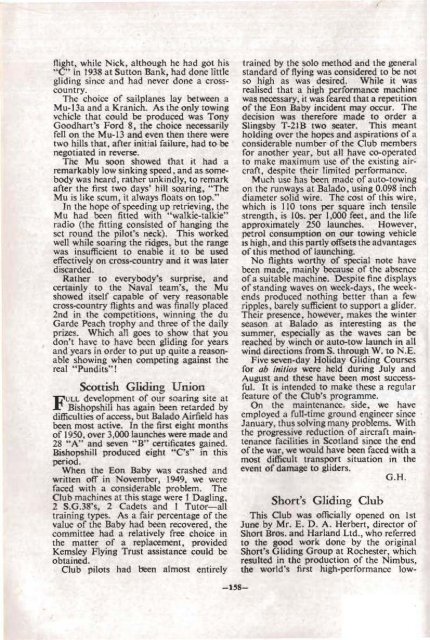Gliding 1950 - Lakes Gliding Club
Gliding 1950 - Lakes Gliding Club
Gliding 1950 - Lakes Gliding Club
You also want an ePaper? Increase the reach of your titles
YUMPU automatically turns print PDFs into web optimized ePapers that Google loves.
flight, while Nick, although he had got his<br />
"C" in 1938 at Sutton Bank, had done little<br />
gliding since and had never done a crosscountry.<br />
The choice of sailplanes lay between a<br />
Mu-13a and a Kranich. As the only towing<br />
vehicle that could be produced was Tony<br />
Goodhart's Ford 8, the choice necessarily<br />
fell on the Mu-13 and evcn then there were<br />
two hills that, after initial failure, had to. be<br />
negotiated in reverse.<br />
The Mu soon showed that it had a<br />
remarkably low sinking speed, and as somebody<br />
was heard, rather unkindly, to remark<br />
after the first two days' hill soaring, "The<br />
Mu is like scum, it always floats on top."<br />
In the hope ofspeeding up retrieving, the<br />
Mu had been fitted with "walkie-talkie"<br />
radio (the fitting consisted of hanging the<br />
set round the pilot's neck). This worked<br />
well while soaring the ridges, but the range<br />
was insufficient to enable it to be used<br />
effectively on cross-country and it was later<br />
discarded.<br />
Rather to everybody's surprise, and<br />
certainly to the Naval team's, the Mu<br />
showed itself capable of very reasonable<br />
cross-country flights and was finally placed<br />
2nd in the competitions, winning the du<br />
Garde Peach trophy and three of the daily<br />
prizes. Which all goes to show that you<br />
don't have to have been gliding for years<br />
and years in order to put up quite a reasonable<br />
showing when competing against the<br />
real "Pundits"!<br />
F<br />
Scottish <strong>Gliding</strong> Umon<br />
ULL development of our soaring site at<br />
Bishopshill has again been retarded by<br />
difficulties ofaccess, but Balado Airfield has<br />
been most active. In the first eight months<br />
of <strong>1950</strong>, over 3,000 launches were made and<br />
28 "A" and seven "B" certificates gained.<br />
Bishopshill produced eight "Cs" in this<br />
period.<br />
When the Eon Baby was crashed and<br />
written off in November, 1949, we were<br />
faced with a considerable problem. The<br />
<strong>Club</strong> machines at this stage were I Dagling,<br />
2 S.G.38's, 2 Cadets and I Tutor-all<br />
training types. As a fair percentage of the<br />
value of the Baby had been recovered, the<br />
committee had a relatively free choice in<br />
the matter of a replacement, provided<br />
Kemsley Flying Trust assistance could be<br />
obtained.<br />
<strong>Club</strong> pilots had !:reen almost entirely<br />
trained by the solo method and the general<br />
standard of flying was considered to be not<br />
so high as was desired. While it was<br />
realised that a high, performance machine<br />
was neoessary, it was feared that a repetition<br />
of the Eon Baby incident may occur. The<br />
decision was therefore made to order a<br />
Slingsby T-ZlB two seater. This meant<br />
holding over lhe hopes and aspirations of a<br />
considerable number of the <strong>Club</strong> members<br />
for another year, but all have co-operated<br />
to make maximum use of the existing aircraft,<br />
despite their limited performance.<br />
Much use has been made of auto-towing<br />
on the runways at Balado, using 0.098 inch<br />
diameter solid wire. Tile cost of this wire,<br />
which is J 10 tons per square 'inch tensile<br />
strength, is 10s. per 1,000 feet, and the life<br />
approximately 250 launches. However,<br />
petrol consumption on our towing vehicle<br />
IS high, and this partly offsets the advantages<br />
of this method of launching.<br />
No flights worthy of special note have<br />
been made, mainly because of the absence<br />
of a suitable machine. Despite fine displays<br />
of s'tanding waves on week-days, the weekends<br />
produced nothing better than a few<br />
ripples, barely sufficient to support a glider.<br />
Th,eir presence, however, makes the winter<br />
season at Balado as interesting as the<br />
summer, especially as the waves :an be<br />
reached by winch or auto-tow launch in all<br />
wind directions from S. through W. to N.E.<br />
Five seven-day Holiday <strong>Gliding</strong> Courses<br />
for ab initios were held during July and<br />
August and these have been most successful.<br />
It is intended to make these a regular<br />
feature of the <strong>Club</strong>'s programme.<br />
On the maintenance. side, we have<br />
employed a full-time ground engineer since<br />
January, thus solving many problems. With<br />
the progressive reduction of aircraft maintenance<br />
facilities in Scotland since the end<br />
ofthe war, we would have been faced with a<br />
most difficult transport situation in the<br />
event of damage to gLiders.<br />
G.H.<br />
Short's <strong>Gliding</strong> <strong>Club</strong><br />
This <strong>Club</strong> was officially opened on 1st<br />
June by Mr. E. D. A. Herbert, director of<br />
Sh,ort Bros. and HlU'land Ltd., who referred<br />
to the good work done by the original<br />
Short's <strong>Gliding</strong> Group at Rochester, which<br />
resulted in the' prodwction of the Nimbus,<br />
the world's first high-performance low-<br />
-158-

















